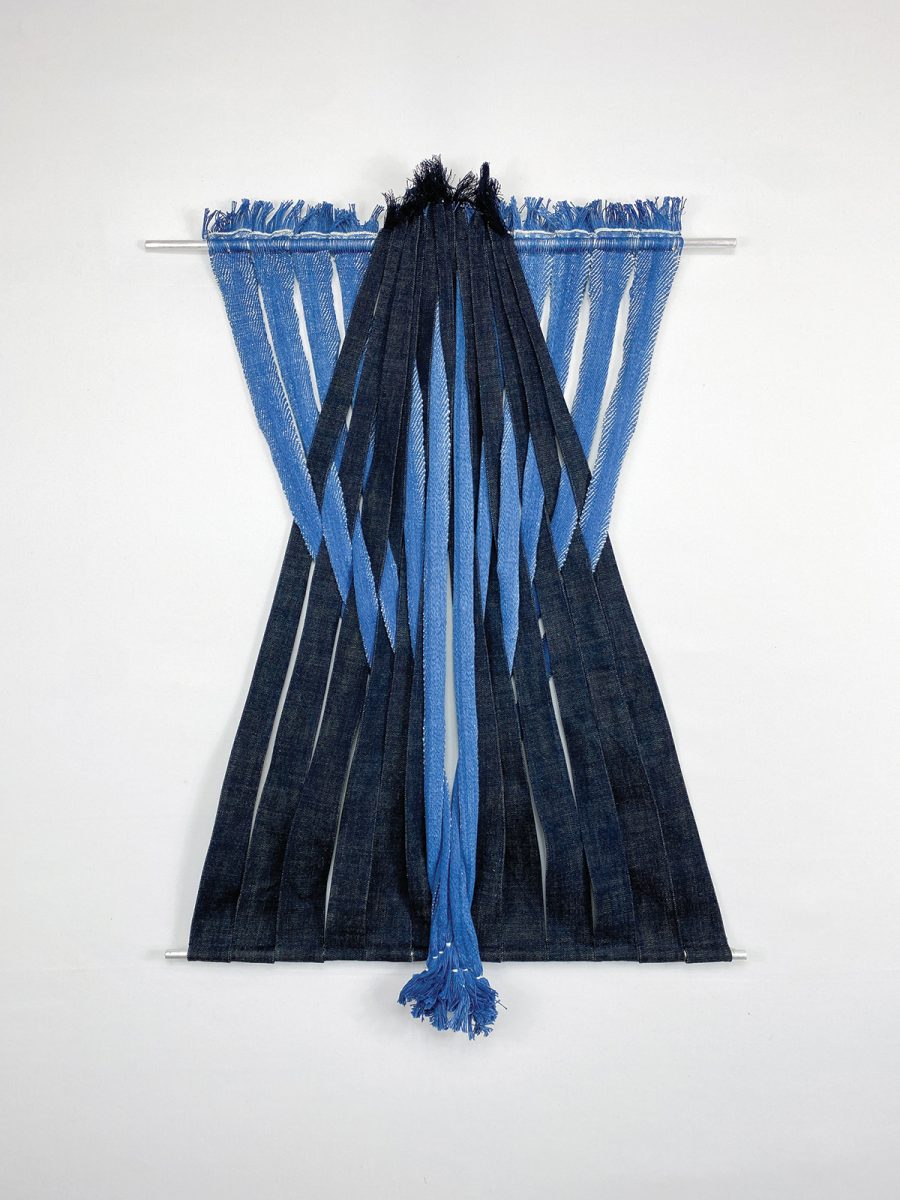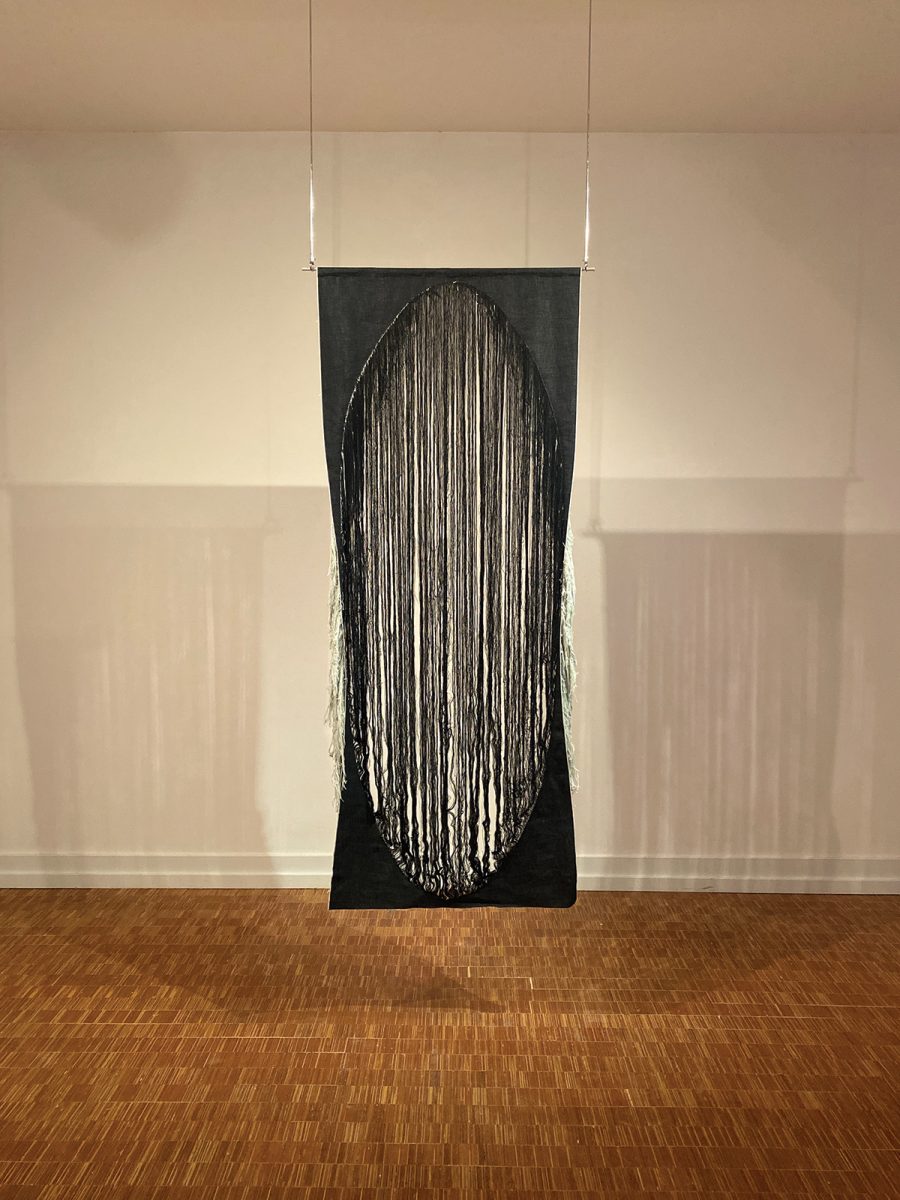Kimberly English considers the world, one stitch at a time
By: Alison Fields

Kimberly English is poised for the big conversations.
Portrait by Colby Rabon
Kimberly English has a lot of ideas about cloth. She’s an artist who works primarily in textiles, so perhaps this is not surprising. But for English, woven materials are more than just a medium.
“Cloth is so rewarding to work with because folks don’t suspect that it can be so powerful. It’s soft and warm, but it’s also primal and necessary,” she says. “I love that it’s human-like. It sags with time and touches you back when you interact with it.

“Because of this of this, fabric is the ultimate trojan horse in talking about big, abstract ideas that get to the heart of the human condition.”
In her conceptual work, English uses cloth to explore themes around survival, belief systems, and “progress” as a record of things made. She acknowledges that weaving is often seen more as craft than art — and she enjoys tiptoeing that line.
“Textiles can speak both languages: function and form,” she says. “Cloth can symbolize security, the body, and time; it can also symbolize labor, violence, and society at large. I enjoy its distinct ability to convey a sense of intimacy and storytelling.”
English was first drawn to textiles as a student at Savannah College of Art and Design. She had left a small, rural hometown in middle Georgia with a strong desire to make art, but without a particular medium in mind.
When she found the fibers department, though, she “soaked everything up like a sponge.”

Later, while studying abroad in France, English was drawn to weaving in particular. “There were some looms in our studio, but no weaving courses were being offered. So I think I traded an older classmate a bottle of wine to show me how to weave one evening,” she says. “I remember the feeling that night of my whole world opening up. It just felt like the way my brain worked — like a language I already spoke. I fell in love with the rhythm and the ritual of the process.
“The beautiful thing about weaving is the intention and the labor that goes into it. I think that’s one of the things that keeps pulling me back to it — it really makes me slow down and grounds me in a way that I haven’t found through any other media.“

Photo by Colby Rabon
Upon return to the U.S., English took all the available weaving classes at SCAD, and went on to UNC-Chapel Hill for a graduate-school program she calls transformative. To her surprise, she moved away from weaving and began working on three-dimensional projects with mostly found and reclaimed fabric.
Material choice became a crucial component in her work, both formally and conceptually. “I really began exploring textile work related to labor, industry, and the history of cloth over those two years,” she says.
Since then, though, English has been finding her way back to weaving. Her two current shows, one local — at Blue Spiral 1 in Asheville as part of Color Stories, and another at Peel Gallery in Carrboro, not far from UNC-Chapel Hill — show the surprising contrasts that can comprise woven work.

Photo by Steve Mann
“The Peel show leans much more conceptual. It’s built around denim. The Blue Spiral show is more technical,” she explains. “My pieces there come out of drafting, which is designing a woven fabric on graph paper based on the type of loom you have. It’s in some ways similar to a puzzle. I love the process because it’s creative, but there are limitations to what you can do. All of these weavings were drafted by hand on many sheets of grid paper, taped together. My primary design concerns were color, activation of negative space, and challenging the grid structure inherent in woven cloth.”
Beyond the shows, English prepares to mark her second year as an Asheville resident by continuing to dip her toes into the local arts community and deepening her connections to it. There’s always the promise of new ideas, which English welcomes.
“Beginning a new body of work often happens unexpectedly,” she says. “Usually there is this magic moment that happens — sometimes from reading, but sometimes it’s a song or a poem. Tangentially related dots all of a sudden start to synthesize. I see the connecting thread. This is the best feeling in the world to me. “
Kimberly English, Asheville. The artist’s work will show at Blue Spiral 1 (38 Biltmore Ave., downtown, bluespiral1.com) as part of the show “Color Stories” through Wednesday, Dec. 28. See kimberly-english.com for more information.

Great article about a wonderful artist. Kimberly emulates the Black Mountain College artistic heritage which she recently became part of with her employment in getting down to the bottom material world layer of her subject before building back up from that foundation. Looking forward to all her future accomplishments!